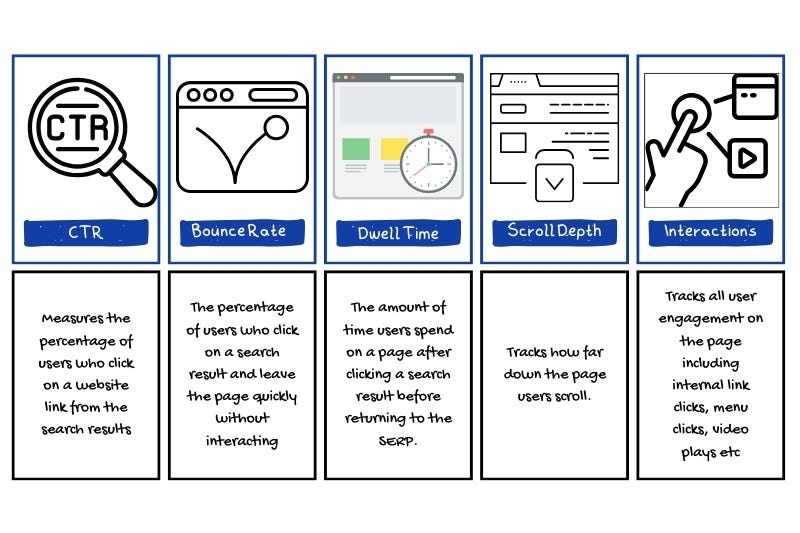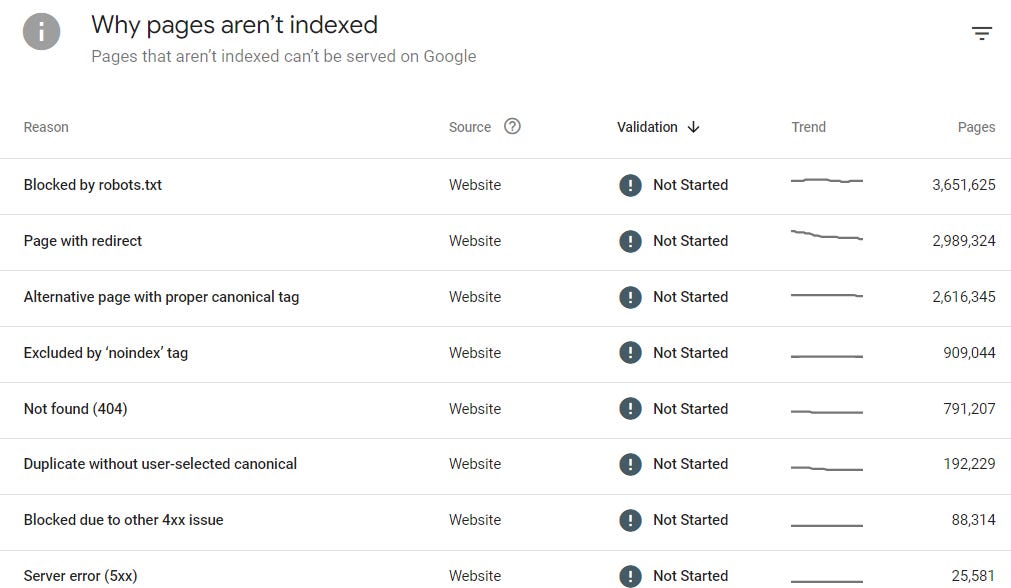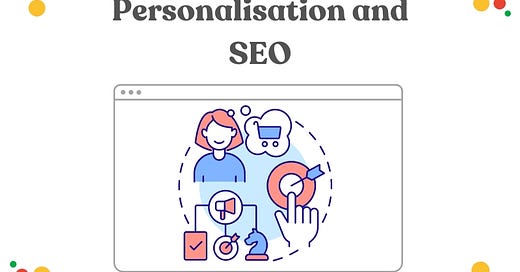What personalisation means for SEO
Website personalisation - a silver bullet or silver tongue for the SEO community?
Now, is personalisation a must have or shit smelling flavour of the month? Trot our the trite ‘it depends’ and move on.
It can certainly create more positive user experiences when done well. Unfortunately, the opposite is almost certainly true.
TL;DR
Website personalisation creates a customised website experience for the individual user
While A/B testing focuses on groups of users to test different versions of content
According to The Google Leak, we've had confirmation Google stores Chrome data and uses it to rank pages over time. So improving session durations, bounce rates and interactions should be a positive
Server-side changes tend to be better for SEO as Google can crawl and index the content. But client-side changes can be a far more time and cost-efficient method
What is website personalisation?
Website personalisation is designed to give users who visit your site a customised experience based on individual or audience data. By creating an experience for the individual, your engagement metrics and conversion rate should significantly increase. Well, theoretically.
I saw a post about a brand that had recently personalised its entire website and saw negative results. Imagine that… All that time spent creating something based on who the individual is, for the individual to tell you they preferred being part of the herd. I’d be livid.
The apparent deprecation of third party cookies has made website personalisation more challenging in recent years. But, since Google’s U-turn (Google announced they are not unilaterally getting rid of third-party cookies on Chrome). Instead, user can make an “informed choice that applies across their web browsing.”

How does it differ from AB testing?
Website personalisation is almost an accumulation of AB tests. You still need to collect audience data, segment the audience into subgroups and target these groups with relevant tests to see if they work.
But personalisation takes it so much further. It’s like traditional AB testing on steroids. Imagine all of the Olympic athletes were on steroids and… Actually, scrap that analogy.
Testing at an individual level would be a ludicrous way to spend time. But if you can accumulate enough data about the individual to make savvy, personalised decisions… You’ll be a man my son. Or woman. Or personalised website guru.
What could it look like for your users?
Broadly, I think it should be very good for your users. Let’s run through a few examples…
Example - publisher
If you’re a publisher who creates content about a whole host of topics, the chances are each user isn’t interested in everything you write about. Imagine a world where the homepage, navigation and notifications each user receives are based on their preferences. Preferences you have analysed over time.

If a user’s engagement metrics are so much stronger for sport and politics, and almost non-existent for fashion and culture. Then prioritising sport and politics on the homepage, navigation and in onward journeys (the right hand rail, More Stories etc) would create a better experience, wouldn’t it?
Example - e-commerce site
Presenting shoppers with a personalised experience seems like a no-brainer doesn’t it? Amazon’s app has been a hotbed for personalisation for years. Even if the cynic in me would say recently all Amazon has done is promote a rubbish product made in China with fake reviews… But that’s not my story to tell.
Some personalisation is easy. Suppose x product has been added to your basket. Then recommending y and z at or around the checkout process is easy. Up and cross-selling based on relevant products has been around for decades, as has auto-adding your card details in the checkout process. It’s there to improve your experience.
But if you have enough data on the individual. Then you can cultivate personalised journeys, product-specific navigation and tailored experiences based on prior purchases.
Lots of my favourite shopping experiences come from clothes sites who tailor their recommendations based on my ‘unusual’ body shape. Wide legs, 29” inside seam and a 31” waist are not particularly normal trouser measurements. The best sites show me products that will fit me.
What is the impact of personalisation on SEO?
There are hundreds, if not thousands of factors that influence SEO. If we look at what I think are the most important;
Brand prominence
User engagement and experience
Content quality
Site quality
And correlate that with what personalisation can offer - an improved user and brand experience, (hopefully) more engaged users and a faster, more seamless path to purchase - you can see why it could be powerful. Showing people what they want, when they want it should engender a more positive experience.
If we assume these things are done well, then it should be very positive. Particularly for publishers. You’ll just need to test the impact, set clear goals for what you are trying to achieve on and off-site and always remember that Google crawls your site as a first time, cookieless user.
Branded searches are considered significant in terms of query matching and brand affinity. This factor directly impacts search rankings by matching queries with ‘preferred brands’, improving the visibility of those brands in search results.
Users trust brands. So does Google.
Factors most likely to be affected by personalisation
User experience
Personalisation should improve time on site, dwell time, and page interactions like scrolling and clicking by offering relevant content, theoretically improving the individual user's experience.
Bounce rate
Offering personalised content should reduce the likelihood of users bouncing quickly from a page, because it’s tailored to their preferences.
CTR from SERPs
Personalisation that leads to relevant snippets in SERPs can improve CTR and snippet quality. I think this one is less certain. But given Google’s proclivity to take anything from a page and use it in the SERPs, it may pick up these personalised elements to display in rich snippets or meta descriptions.
Google uses CTR as a behavioural signal to assess how relevant a result is to a query. If a personalised result consistently receives higher CTR, it suggests to Google that the page is highly relevant, which can lead to a ranking boost for that specific (or similar) queries.
Page engagement metrics
Personalisation can increase interaction rates with certain elements, like menus and product suggestions, improving engagement. As Google stores a substantial amount of Chrome user data to gauge page engagement (counts of specific user actions, clicks, page views and broader browsing behaviour like scroll depth, cookies), improving these could have very positive ramifications.

Conversion rate
E-commerce sites have benefited from personalised product recommendations for years. Up-selling, cross-selling, point-of-purchase selling etc. For publishers, your conversion journey will be more experience-based, particularly if you’re a paywalled publisher. But the concept is exactly the same. Build something people want to be a part of and will pay for.
Keyword relevance
There’s a chance that too much personalisation can dilute focused, keyword-rich content, affecting overall content quality and relevance for queries. Over the years we’ve become pretty good at creating content that satiates the masses and the individual—contextual relevancy, relevant queries and questions, related content, blah blah blah. We’ve been doing this pretty well for a while.
If you take anything away from this, it’s to be careful what you personalise. Some things are worth it. Some will go too far.
Crawling and indexing
Dynamic, personalised content can confuse crawlers or prevent them from indexing more important content. Or at least prevent them from being crawled as frequently. Any dynamic changes you put in place that create additional pages should be done carefully. Suddenly 10x the size of your website is rarely a good thing.

Consider how to handle your crawl budget effectively;
Utilise your robots.txt file diligently
Ensure canonical tags are applied correctly
Apply noindex,nofollow tags appropriately
Have you significantly increased the total number of pages on your site? Ask yourself the question, is it worth it?
Remember that noindexing alone doesn’t improve your crawl budget. To do that, you’d need to implement a <meta name="robots" content="noindex, nofollow" /> meta tag.
URL structure
If personalisation creates dynamic URLs without proper handling, it can lead to duplicate content or complicated URL issues. Frankly, issues like these are a nightmare to deal with, so stopping this at source is an excellent idea.
This is where server-side vs client-side personalisation strategies come into play.
Server-side vs client-side personalisation
With a server-side approach, the personalisation is done on the server before the webpage is delivered to the user. The server tailors the HTML response based on user-specific data (e.g., user profiles, purchase history, or geolocation - see international SEO). So before the HTML is delivered to the browser, the server generates personalised content based on prior user data, sessions and API calls.
For SEO purposes, a server-side approach is almost always preferable because search engines (or Google, who are we kidding) and crawl the content. If you don’t want the content crawled and you want the fastest possible experience (with minimal FOUC - Flash of Unstyle Content), then a client-side approach may be better.
With a client-side approach, personalisation is done through code that runs in the browser (e.g., JavaScript). After the page loads, content is dynamically adjusted based on user data (like cookies or local storage).

The server sends a ‘generic’ page to the browser and the client-side script generates personalised content. Faster after the first load and significantly easier to implement. There’s a reason tech teams would usually rather build something on the client-side. But it’s a far more limited approach that does lead to FOUC and performance issues.
But both use cases have their purposes. A client-side approach will be faster, so a good option for testing. But is far more limited than a server-side implementation, particularly for SEO purposes.
It’s not uncommon for brands to take a hybrid approach, where the user will see a personalised homepage (server-side rendering) and additional personalisation is done on the client side. Given how time-consuming server-side work can be, this is almost certainly the right approach for most of us.
When it comes to crawl budget and URL issues, a client-side approach is infinitely worse because it can result in separate URLs for different versions of the page (e.g., "example.com/page?version=a" or "example.com/page/segment-1”).
Whereas a server-side approach only requires one URL. Because changes are made at the server-side.
How to integrate personalisation into your SEO strategy
Right now, I think it’s unlikely that personalisation will fall under your remit as an SEO. It’s far more likely that a wider business decision is made to try and cultivate the best possible user experience, leading to website personalisation. Your job is to make it work and ensure it improves the experience for users and search engines and drives quality traffic.
The best way to plan for that is to establish your options and then put frameworks in place to ensure it serves search needs. If it doesn’t create content
Before jumping in to any of the above, make sure you run AB tests to establish whether the personalisation options you have at your disposal work.
Do they improve engagement metrics on page and on site?
What content types should this be rolled out on?
Does it work for every user?
If you were to leverage your user’s demographic data to serve them content better suited to their location, age and personal preferences, is that what they want? Personalisation is not a small undertaking, so make sure you help establish some ground rules.
While boosting relevance for repeat visitors seems like a no brainer, can you make it work?
The Power of Documentation in SEO
TL;DR You should always aim to leave any role and any job in a better position than you found it in. Documentation is a fantastic way of doing so






